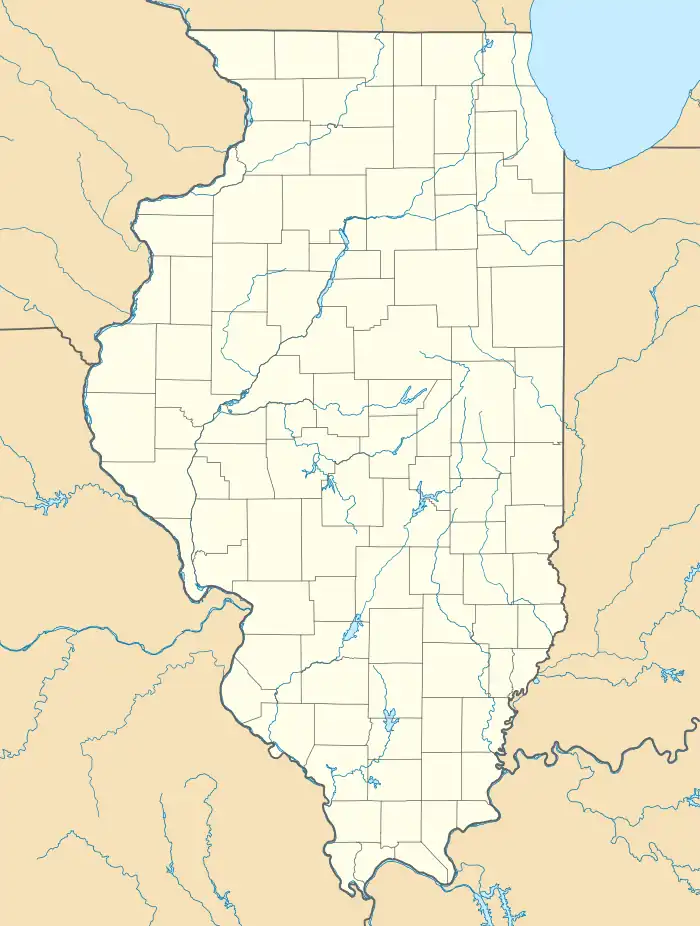Nauvoo Historic District | |
.jpg.webp) Joseph Smith Homestead | |
  | |
| Location | Nauvoo, Illinois |
|---|---|
| Coordinates | 40°32′53″N 91°22′55″W / 40.548°N 91.382°W |
| Area | 3,850 acres (1,560 ha) |
| Built | 1839 |
| NRHP reference No. | 66000321 |
| Significant dates | |
| Added to NRHP | October 15, 1966[1] |
| Designated NHLD | January 20, 1961[2] |
Nauvoo Historic District is a National Historic Landmark District containing the city of Nauvoo, Illinois. The historic district is nearly coterminous with the City of Nauvoo as it was incorporated in 1840, but it also includes the Pioneer Saints Cemetery (40°32′13″N 91°21′03″W / 40.5369°N 91.3507°W), the oldest Mormon cemetery in the area, which is outside the town boundary.[3]
Contributing structures include:
- Brigham Young Home
- Calvin Pendleton Home and School
- Concert Hall (no longer in existence)
- Cultural Hall (Masonic Lodge)
- David Sessions Home
- Edward Hunter Home
- Heber C. Kimball House
- John Taylor Home, Printshop, and Post Office (Times and Seasons Building)
- Jonathan Browning Houses and Workshops
- Joseph Smith Homestead
- Joseph Smith Mansion House
- Lucy Mack Smith Home
- Lyon Drug Store
- Nauvoo House
- Nauvoo Illinois Temple
- Nauvoo Visitors Center
- Newel K. Whitney Home (Private residence)
- Orson Hyde Home
- Red Brick Store
- Riser Boot and Shoe Shop
- Sarah Granger Kimball Home
- Scovil Bakery
- Seventies Hall
- Smith Family Cemetery
- Stoddard Tin Shop
- Webb Blacksmith Shop
- West Grove
- Wilford Woodruff House
- Willard Richards Home (Private residence)
- William Gheen Home
- William Weeks Home
- Yearsley House (Missionary house)

There are many non-contributing, modern structures in the district.
The district was declared a National Historic Landmark in 1961.[2] It is significant as the headquarters of The Church of Jesus Christ of Latter-day Saints (LDS Church) from 1839 and 1846, and as an important early example of community planning by the LDS church. The city's basic plan is still discernible despite the many modern intrusions, and there are a wealth of historical archaeological sites related to the early LDS settlement period, including the site of the main temple, which occupied a prominent location in the city; it was burned in 1848 and its remains were leveled by a tornado in 1865. Due to the large influx of Mormons, Nauvoo became Illinois's largest city for a brief period in the 1840s. Despite this, it lacked a distinct commercial center, consisting mainly of residences laid out on broad streets on a rectangular grid.[3]
The Mormons were forced out of Nauvoo in 1848. The formerly Mormon houses were then used as homes by others for the following century. In the mid-1950s, Mormon preservationists began to purchase and restore Mormon sites to create a cultural center related to the history of Mormonism.[3]
See also
References
- ↑ "National Register Information System". National Register of Historic Places. National Park Service. January 23, 2007.
- 1 2 "Nauvoo Historic District". National Historic Landmark summary listing. National Park Service. Archived from the original on June 6, 2011. Retrieved October 12, 2007.
- 1 2 3 Blanche Higgins Schroer and Ray H. Mattison (March 27, 1976) National Register of Historic Places Inventory-Nomination: Nauvoo, Illinois, National Park Service and Accompanying 12 images, from 1975 or undated, including one engraving reproduced from an 1873 book.
External links
- Historic Nauvoo - information on Nauvoo's historic sites, from the Illinois Nauvoo Mission of the Church of Jesus Christ of Latter-day Saints